#documentary research
Explore tagged Tumblr posts
Text
Documentary Research - 3 Photographers
As my documentary project will be an infrared landscape one, I will be drawing inspiration from and researching both infrared photographers as well as traditional landscape photographers - as both will give me separate insight into composition as well as technical aspects etc.
Ansel Adams


Ansel Adams was a famous landscape and still life photographer. His landscape work consists largely of mountain ranges and peaks of National Parks in West America such as Yosemite and Yellowstone that were always very well thought out and meticulously calculated in terms of composition. He was an advocate for preservation and conservation of these areas.
Adams was an advocate for “pure” photography - a photographic style that denotes ultra sharp focus enhanced by the use of a very extensive depth of field - even going as far as helping found the movement group “f64″. Adams featured the full tonal range of a scene in his photographs, from bright whites to blacks, which resulted in very visually striking outcomes. It is also worth noting that Adams occasionally shot using infrared film to achieve a high level of contrast in his photos by darkening skies and bringing out highlights on mountains to bring out their texture. This is very similar to what I would like to achieve with my own work so referring back to Adams work while shooting will definitely help me.
2. Richard Mosse


Richard Mosse is an Irish conceptual documentary photographer. Primarily focusing on war reportage of conflicts in multiple African and asian countries, he does this with a very unconventional approach compared to other war photographers - using alternative printing and film techniques and equipment, such as infrared colour film, to produce vibrant other-worldly scenes intended to create a new perspective on the conflicts happening in the countries he visits. He is arguably most well known for their series taken of the war in the Eastern Democratic Republic of Congo, taken on Kodak Aerochrome false colour infrared film which was intended for military reconnaissance use, so was a conscious film choice by Mosse. The vivid saturated colours contrast with the underlying narrative of what the scenes depict which is why I think they do well to provoke such emotion which is what I think war photographs should do.
It is very likely that mosse would have had to consider the moral implications of depicting these scenes of violence and death in an arguably pretty and scenic way could be misconstrued as an act of glorifying war.
3. Fay Godwin


Godwin was an English photographer and environmentalist. She developed a practice for landscapes in her thirties from being a dedicated hill walker. From a younger age, she honed her skills as a photographer from taking portraits of her family.
Godwins black and white film landscape work is what she is most known for, however - heavily featuring the British countryside, often with a focus on how mans intervention has affected the landscape. But what I find most intriguing and impressive about her work is her ability to create strong and thought provoking photographs from scenes that lack any real point of interest, instead using her master skill of composition and light to add atmosphere to her photos. I feel that drawing inspiration from her photos will help me with my project greatly as I will also be shooting similar landscapes with a rural feeling to them, so channeling her expert use of composition and light, combined with my use of infrared should result in some very striking landscape images for my zine.
1 note
·
View note
Text
The truth about Dr. Fauci is coming out next week in a documentary called ‘Thank you, Dr. Fauci’.
An indictment against the ‘scientist’ who killed 20 million people. This trailer is already banned by his propaganda partners, the big tech and media billionaires. 🤔
#pay attention#educate yourselves#educate yourself#knowledge is power#reeducate yourselves#reeducate yourself#think about it#think for yourselves#think for yourself#do your homework#do your research#do some research#do your own research#ask yourself questions#question everything#government corruption#news#evil lives here#documentary#truth be told
506 notes
·
View notes
Text
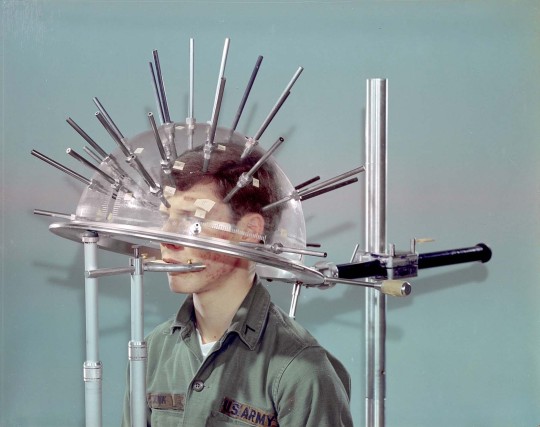
“Head Measuring Device for Helmets” | Military Research at Natick Soldier Systems Center. [1973]
729 notes
·
View notes
Note
when they've got interpreting spiderman noir under a specific cultural lens at the function [picture of me going insane]
I cant help myself.. what can i say. And since you've mentioned some research going on behind the scenes.. do you have any fun interpretations? Or even anything fun about the 1800s!

OH HI
Hm. I don't have anything as fun as historical dancing, but I suppose this does give me the excuse (thabk u) to blab about Noir's childishness.
(wow putting this under the cut bc it got longer than I thought it would LMAO)
I think what a lot of people (including Noir's contemporary writers and yes even the spiderverse interpretation) fall for when trying to read Noir's character is the imitation of his idea of what an adult is, that he hides behind. Like Noir's persona is incredibly exaggerated. He's playing pretend. Look here, he's practicing.

A lot of his persona as Noir is imitation! Imitation of his uncle, of Urich, of the violence he's been exposed to. He's running around in his uncle's old uniform. Fundamentally misunderstanding WHY his uncle had been ashamed of it and his role in the war.

And then he goes ahead and steals Urich's alias because it sounds Cool (which is such a teenage thing to do jesus christ).

But like that imitation of The Adult isn't something that's limited to that exaggerated persona that Noir encapsulates. Peter himself is trying So Hard to be grown up and tough and responsible that it loops back around to him being a brat who would try the three guys in a trench coat trick. He even gets beat up for it when trying to defend his aunt. And I mean I've posted about him being a brat.
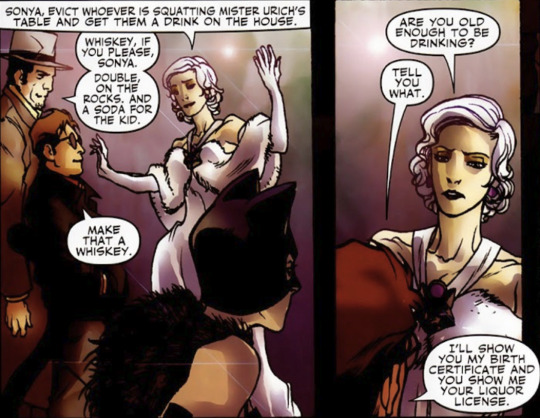
About how he looks at Urich as a Prime Example of what a strong and knowledgeable adult is (which is part of why he reacts so volatile in response to Urich showing he's not exactly as morally righteous as himself, he's wounded and let down). Whiskey? Whiskey sounds like someone Mature and Cool would drink, I'll have it too. And then proceeds to throw his drink at Osborn and laugh about it. The illusion was broken for me then.

But well it's not broken for everyone. I mean like obviously I poked at the contemporary writers, but I'm more talking about the other characters in the narrative. Mainly Urich and Felicia.

Urich taking Peter under his wing isn't entirely under the motivation to nurture Peter. I think it Becomes that, but he's really envious of that kid. He wants to see him lose that hope that he once had (ruh roh the opposite thing happened, being around the kid made YOU more hopeful Ben. Guess you gotta be good. Hope you don't die now).
Urich really is exposing him to an extremely harsh reality, and taking him places where adults are typically only allowed. He's letting Peter get a glimpse into what it's like, which will eventually enable Noir's tool of violence. All these tests will accumulate into what Peter thinks someone powerful and strong can be and do.

Then his problematic relationship with Felicia (writers I'm malleting you for this). He's clinging to her adulthood and the safety she represents, and he's young but she sees some adult strength in him. I mean she trusts him with the blackmail Urich gave her, which she really. Shouldn't, even if that's what Urich wanted.
Anyway, strength is something she's been consistently drawn to her in her partners. Strength to feel as her own. Even if it's to hers and others' detriment. There's also a part of Peter that's drawn to Felicia because Urich was. He's still honing in the good parts of Urich he wants to be.


I think the one person in the narrative who doesn't fall for it? Is Aunt May. You could argue it's just her being naturally motherly, but for someone who was about to be eaten alive she's pretty frank with Noir. I think she can see that that violence and exaggerated grittiness comes from someone inexperienced and young. Even if she can't consciously recognize the similarities between Noir's persona and Peter's protectiveness of her. I don't think she wants to see that. I actually have a short comic script about that, but it probably will never see the light of day.


Ugh he's like a cat puffing up to scare away a predator. It's fake!!!!! It's all fake!!!!!! He gets intimidated by JJ, he never ties his shoes, gets powers and then immediately guns to beat the shit out of Osborn, sings about the sandman when he's getting his face bashed in, crawls to Felicia all pathetic and sad, and he made a costume to run over roofs at night in.
And it's funny how he's forcing himself to grow up, but also really sad because all the things he's being exposed to is already forcing him to grow up. He's witnessing things no kid should ever see or experience.
Then there's the time period to consider. The aftermath of WWI, being in the midst of the Great Depression, and WWII just around the corner. He's faced incredible hardship and is going to continue to face so much hardship, and he's going to mature faster than he ever should have. It should have made him crash and burn Hard when he became an adult, and to me he still does because I'm ignoring everyone after ewaof LMAO.
As for my research on the 1800s NY that's for my own spider iteration run I'm working on, so not too related to Noir until I reach the 30's :3
Hope that was satisfying!!
#tw grooming#critter talks#asks#the moots#fool!!!!!!#spider man noir#character analysis#abt the research like logically I know the typical new yorker isn't gonna know abt the specificities of the original dutch colony#and intricacies that the boom of industrialization had on lower class communities#but it's less about that and more of digging my hands into the Soul of NY#because NY is so Intertwined with any spider#so I'm starting from the Very beginning and digging my way up. man y'all were a hot mess#it's really fascinating though working my way through documentaries and books. the list is long and the dent I've made is about an 8th ASDF#anyway MAYBE y'all will see spiderman undiscovered one day...ask me abt it again if y'all like miles being a detective w a shoulder demon#for now it's me my 55 of world building slides several character note docs and a to read list of about 20 books long#would like to go to NY citay one day & oogle at the stinky subway draw some storefronts and people watch but thats not in the budget rn#also trying to look for movies n shows that aren't exaggerations of the culture so if anyone has recommendations DO @ me please#wanna do her justice bc I care about her#ALSO FOOL I'M SO SORRY FOR TAKING A DAY TO ANSWER#had to get my thoughts togther
126 notes
·
View notes
Text
You know my fanfic is going to be good when I pull out verified medical sites for it and make accurate documents to summarize & reference information
Anyways, if anybody wants a docs project full of information about eye burns, ask!
(Also, don’t ever research about eye burns unless you want to be jump-scared by countless of pictures of burned faces. A trigger warning is apparently not a thing on medical sites) (learned that the hard way)
#ninjago#archive of our own#silkieluv#ninjago jay#ninjago season 6#fanfic#lego ninjago#ao3 writer#skybound#ninjago nadakhan#eyeburn#eyes#documentation#documentary#google docs#research#hard work
24 notes
·
View notes
Text
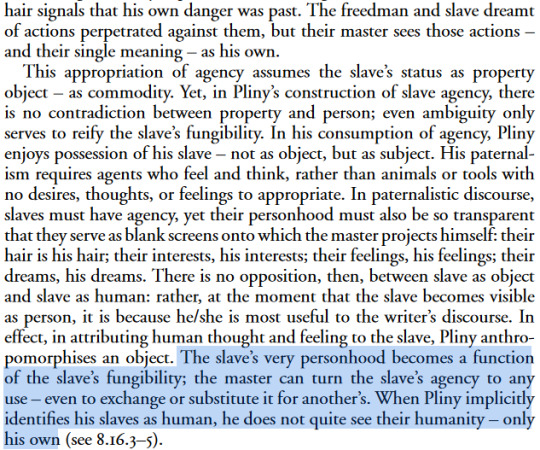
Slavery and Roman Literary Culture, Sandra R. Joshel
#i have a small collection of texts on greek & roman slavery in the late republic era and the early empire from doing#a bunch of research for a spartacus comic and this is something that rattles around in my head constantly#i dont have a reading tag bc i have a sideblog for that but hey! what's the point of a blog if not to post on it#anyway! horrific! that one quote from the spartacus documentary. that the worst thing was to 'get used to it.'#there's a previous part in this text about the assimilation of identity and the violence of benevolence etc#(i also had to do a lot of this for the crassus comic and unlocked a new debate about his wealth that keeps me up at night for other reason#like. i need a map. actually i need several maps and a spanish dictionary)#roman slavery tag
117 notes
·
View notes
Text
*This poll was submitted to us and we simply posted it so people could vote and discuss their opinions on the matter. If you’d like for us to ask the internet a question for you, feel free to drop the poll of your choice in our inbox and we’ll post them anonymously (for more info, please check our pinned post).
#poll#polls#yes or no#documentary#incognito polls#poll time#random polls#tumblr poll#tumblr polls#fun polls#yes or no poll#yes or no polls#research#education#entertainment
24 notes
·
View notes
Text
WAKE UP ITS HAMILTON TIME (hamilton pt 1)
everyone thank richard for getting me to put all my knowledge about alexander hamilton in one place. if you're at all new or confused, @thereallvrb0y once asked me 3 years ago to tell him everything about every historical figure i can, and since then i have been doing that. now we are onto the last one on the list he gave me, and studying hamilton is literally my life's work, so here it is. on tumblr.com. for free.
my sources for this are Ron Chernow and Hamilton himself and a strange amalgamation of knowledge from different museums, documentaries, interviews with historians, and other otherwise publicly accessible knowledge that i have compiled into the vast library inside my mind! you can find my notes in the link in my pinned post. let's go (this historical research is sponsored by the ghost of freddie mercury and my aunt who made me a whole pot of coffee)
Background Information
Ron Chernow loves to talk about how the island of St. Kitts and Nevis was formed, but that's not fucking important. What's important about Hamilton's birthplace is that it was positioned in the Caribbean in such a way that made it a very easily accessible port, however the coastline was pretty smooth which made it generally unideal for mooring ships.
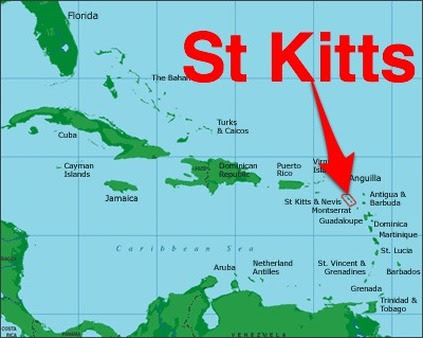
Source: The St. Kitts' Scenic Railway; Six Frigates: The Epic History of the Founding of the US Navy by Ian W. Toll, p. 112 ("Basseterre Roads was not a good natural harbor. It was little more than a dent in the otherwise smooth coastline that ran along the western side of the island. There was no pier- visitors were obliged to run their boats directly onto the beach, sometimes surfing in on waves that broke heavily as they reached the shore.")
Now, notice that St. Kitts and Nevis is, in geographic terms, to the right-ish of the Caribbean. That means when you're coming from Jolly Ole England, you might make a pit stop in St. Kitts and Nevis. So if you ignore the fact that the island has no natural harbor (at least not a good one), it might be a good economic prospect for a young merchant, right?
Well, not if that merchant is James Hamilton, because he was an idiot. And I say that lovingly, or at least more lovingly than Ron Chernow did. Ron Chernow also emphasized that St. Kitts and Nevis was filled with the 18th century version of Shameless, and also Jewish people. Ron Chernow might not hate Jewish people, but he does hate the character archetypes in Shameless. In Shameless terms, James Hamilton was like Frank Gallagher.
Disclaimer: knowledge of Shameless is not necessary to understand that being compared to a guy named Frank is not a good thing
I've already made posts about Hamilton's parents and brother (here, if you'd like to read that ig. weirdo), but I want to talk about the things that Hamilton would have learned from his parents. Later in life, Hamilton vaguely alluded to his father's failings in business being due to an excessive amount of generosity and not really understanding where he should and shouldn't spend his money. This did not by any means make Hamilton stingy with his money, or even smart, for that matter, but it did make him want to be something specific: independent.
James Hamilton's tragic flaw was his dependence on other people, whether it was his older brother or Rachel Faucette or his business partners, etc. Due to the position and order in which he was born, James was never destined to be a leader. He wasn't exceptional academically like other non-first-born-sons, such as James Madison, or dispositionally inclined to organize and inspire, like George Washington. He was just a dude, and he was a dude who was not built for 18th century society, especially not in the Caribbean. From what we can tell, James Hamilton was a gullible, moderately intelligent man with symptoms of autism and non-descript mental health issues. He was basically fucked from the get-go.
Source: Alexander Hamilton by Ron Chernow (p. 12-16); Papers of Alexander Hamilton, vol. 25, p. 89, letter to William Jackson, August 26, 1800 ("In a capacity of a merchant he went to St. Kitts, where from too generous and too easy a temper he failed in business and at length fell into indigent circumstances.")
Rachel Faucette was like James Hamilton's polar opposite. She was forced to learn how to provide for herself, not being able to rely on anyone, because that could be ripped out from under her feet at any moment, and the only thing concrete in her life was herself. She was a woman, and that was what most women had to learn at some point.
Rachel was also perfectly poised to be the clear moral guide for young Hamilton. When James Hamilton left, he basically sacrificed any reverence his son might have for him, and instituted Rachel as Hamilton's sole role model for his developmental years and i just burned the shit out of my hand with coffee.
Disclaimer: James Hamilton had nothing to do with me burning the shit out of my hand with coffee, I promise. You can't blame all your problems on deadbeat dads
If you're a Sigmund Freud fan, (good opener, I know), you're aware of the Oedipus Complex, and that's not exactly what I'm talking about, but yk. look it up. This theory proposed by Freud was only partially rejected by the psychological field (due to the fact that not everything is about wanting to fuck your mom and kill your dad, and also that's not the story of Oedipus Rex like. at all??), but the part that still rang true was that children do have a unique attachment to the opposite sex parent.
Psychological studies show that children tend to describe their opposite sex parents more favorably than same sex parents. Why? I don't know, I'm not a psychologist, I'm an 18 year old who drinks coffee like he was 5 kids to raise.
Source: "The Relation between Attachment to Opposite Sex Parents and Attachment to Romantic Partners" by Gary L. Grogan and Dr. Mary E. Pritchard, p. 10 ("However, most significant for the present inquiry were the findings that respondents described their opposite sex parents more favorably, and same sex parents more critically.")
This statistic is visible in Hamilton's descriptions of his parents, and must have been enhanced by James Hamilton's early departure in his son's life, the consequences from that which seemed constant, but also by the reputation his father had built on the island he left Hamilton on. Hamilton would grow up to see his mother not only providing for herself and her children, but also overcoming the consequences of James' actions, which provoked resentment towards his father, and admiration towards his mother. This will develop as a theme throughout his life, but we'll touch on that as he grows up. He isn't even born yet! So let's get on to that.
Source: so when I say Hamilton's description of his mother, I really mean HIS son's, but JCH most likely got this description from his father, Life of Alexander Hamilton by John Church Hamilton, vol. 1, pg. 42 ("...a woman of superior intellect, elevated sentiment, and unusual grace of person and manner. To her he was indebted for his genius."); for the sake of my reliability and reputation, I'll include JCH's description of his grandfather for comparison, Intimate Life of Alexander Hamilton by John Church Hamilton, p. 13 ("Hamilton's father does not appear to have been successful in any pursuit, but in many ways was a great deal of a dreamer, and something of a student, whose chief happiness seemed to be in the society of his beautiful and talented wife, who was in every way intellectually his superior.")
Early Life
Alexander Hamilton was born ginger on January 11, 1755, and I don't entertain the argument that he was born in 1757 because I'm not an anarchist and I believe society has laws (I'm actually lying, I'll talk about the birth year debate in the college section). Hamilton was not, however, born black or Jewish. He was also, potentially, born not James Hamilton's son.
"Wh- WHAT?! *cries*" I hear you say, and I know, it's shocking information, but yes. First off, Hamilton was not black in any percentage more than the Pillsbury dough boy is black. This theory comes from the fact that Rachel Faucette was a lower class woman and therefore we have no proof that she WASN'T partially black. I don't even have to dispute that for anyone with a gram of critical thinking skills to see that that isn't a valid historical hypothesis.
The Jewish thing has a little more merit to it, and there's a whole book about it that I haven't read. There is some evidence to suggest that Rachel Faucette's ex husband, Johann Lavien, could have been a secret Jewish person, and possibly caused Rachel herself to convert, and she tried to pass on that to Hamilton by having a Jewish woman educate him when he was a toddler (that last part is a true fact, and is the earliest piece of information we have about Hamilton's education). If this is true, (and it's nearly impossible to prove true or false because well if Lavien was a secret Jew, it was a secret), it did not impact Hamilton's religious beliefs in any way, and he identified as a Christian throughout his entire life.
We'll do a paternity test on Hamilton later, just hang tight. See, this is how I get you, I say something controversial, and then I don't talk about it until 16 paragraphs later.
Source: Alexander Hamilton by Ron Chernow, p. 9 ("A persistent mythology in the Caribbean asserts that Rachel was partly black, making Alexander Hamilton a quadroon or an octoroon. In this obsessively race-conscious society, however, Rachel was invariably listed among the whites on local tax rolls. Her identification as someone of mixed race has no basis in verifiable fact. (See pages 734-35 [this is in Chernow's Acknowledgments, and he just talks about how he used a paper trail to come to this conclusion, and thought genetic research would only confuse the evidence. He also discusses that there is a small chance that Hamilton fathered a black child named William Hamilton, but I can go ahead and tell you that's false due to the fact that Hamilton had just arrived in America when William was born -HWS]) The folklore that Hamilton was mulatto probably arose from the incontestable truth that many, if not most, illegitimate children in the West Indies bore mixed blood."); Life of Alexander Hamilton by John Church Hamilton, vol. 1, p. 42 ("...rarely as he alluded to his personal history, he mentioned with a smile his having been taught to repeat the Decalogue in Hebrew, at the school of a Jewess, when so small that he was placed standing by her side upon a table); Ibid., vol. 7, p. 710-11; Papers of Alexander Hamilton, vol. 26, p. 774, "Comments on Jews"
Hamilton's education began with his mother, who is almost definitely the person who made him fluent in French by the time he came to America. Despite limited access to books (34 books in both French and English to be specific), Hamilton still studied everything he could from a young age, with an early love for learning new things and proving that he was smarter than you. However, most of his education was in the School of Hard Knocks Community College, which was amply provided by the environment around him.
In the height of the British Empire, the Caribbean was essentially a social prison for anyone who broke the moral laws of the colonial, Eurocentric society of the time. This included pirates, prostitutes, drunks, thieves, and basically anyone who didn't fit the mold for a member of high society and/or someone who could serve high society and their lives of luxury. Hamilton, by birth, was one of these people.
Hamilton's father moved the family to St. Croix right before he left, which was a dramatic shift from Hamilton's life on St. Kitts and Nevis. In St. Croix, everyone knew Hamilton's mother as the disgraced ex-wife of Johann Lavien, and therefore knew her two sons as "whore-children", which was a word usually given to illegitimate children. Here, Hamilton was roped in with the degenerates of society, and it was practically said directly to him that he was destined to be unholy, unclean, worthless, and disgusting. Could you believe that this would have an impact on his mental health?
Along with seeing the poor lifestyles of the inhabitants of the Caribbean, Hamilton also saw glimpses into a very different world: ~rich people~. There were few rich white people on the islands, and they owned vast amounts of enslaved people, with the black to white ratio being 8:1 in the Caribbean. These enslaved people were forced to live in horrible conditions, and Hamilton saw it everywhere- his mother owned three people, but they were often rented out to garner profit for the white family, rather than working a plantation as others in the Caribbean did. Violence towards enslaved black people was only part of the violence young Hamilton witnessed in the Caribbean, some of which came in the form of dueling *insert ominous music*
Source: Alexander Hamilton by Ron Chernow, p. 18 ("To the extent that dueling later entranced Hamilton to an unhealthy degree, this fascination may have originated in the most fabled event in Nevis in the 1750s [a duel between two men where one of them was killed"); Ibid., p. 19; Ibid., p. 23-24
James Hamilton abandoned the family in 1765, and the reasons he did so are debated, but most likely are due to debt. However, there's another possibility that I've alluded to before: Hamilton's paternity.

So, remember, Rachel Faucette is not a perfect angel, and she also didn't particularly care for matrimony. There is a chance that she was with other men besides Hamilton and Lavien, and though we have no evidence that she was, there is an interesting character I'd like to throw into the mix.
Thomas Stevens, a moderately rich guy, was a merchant who lived on King Street in Charleston, St. Croix, with his wife Ann and his son Edward, who was born a year before Alexander Hamilton. Thomas Stevens was a very generous guy, and Edward Stevens would later be lifelong friends with Alexander Hamilton. And uh. They looked almost exactly the same. I really wish we had a portrait of Edward Stevens, but according to literally everyone, it was hard to tell the difference between him and Hamilton. Now, statistically, we all have some kind of doppelganger out there, but like what are the chances that they grew up down the street from each other and their parents had suspiciously close connections? Now, I'm not saying that Hamilton should have been Alexander Stevens, I think that's pretty irrelevant, but it is possible that Thomas Stevens... you... ARE THE FATHER!!!
Source: Alexander Hamilton by Ron Chernow, p. 27-28 ("Nevertheless, in the absence of direct proof, the notion that Alexander was the biological son of Thomas Stevens instead of James Hamilton would clarify many oddities in Hamilton's biography.")
The Hamiltons' life post-dad-desertion was actually somewhat comfortable due to Rachel's kickassery. She established a little store for a source of income, relocated a couple times, rented out the enslaved people (as one does, i guess, that's such a wild phrase), and kept a pet goat for milk and cheese and idk soap or whatever else people make with goat milk. Her sons would help out, possibly providing an origin for Hamilton's incessant need to be productive at all times without resting. At times, they were supported by his aunt Ann Lytton Mitchell, who he would remain loyal to until his death. During this time, as he was old enough to understand what his father did, is probably when his fiercely loyal, chivalrous and family-driven attitude developed.
Source: Alexander Hamilton by Ron Chernow, p. 22-23; Ibid., p. 28
I'm so hopped up on caffeine I could do a triathalon.
Hamilton and his mother were both afflicted by a strange and unspecified illness in the winter of 1768. The primary symptom was a severe fever, and they were treated with purgatives, medicinal herbs, and bloodletting. Nothing helped, and Rachel died at 9 pm on February 19. Hamilton miraculously survived.
Immediately, Hamilton and his brother James had everything they owned taken away, indebted by bills charged against them by local debtors. Their half brother inherited whatever else belonged to their mother, which brought up the marital scandal all over again, beginning a legal battle that lasted for around a year. In the end, the two Hamilton brothers were left with two things: jack shit and fuck all.
Custody of the two boys was appointed to their cousin, Peter Lytton. In my notes, I described him as "white trash" and "insane", including the quotes, so idk who said that. Peter Lytton lived with his black mistress and their illegitimate child. He killed himself on July 6, 1769, and what's strange about that is that we don't know if he shot or stabbed himself. I don't know who got confused about the difference between a knife and a gun, but that isn't my problem.
To make a bad situation worse, Peter Lytton didn't leave the boys anything in his will, and neither did his father, who did "his best" to help. His best could have been even just mentioning the name Hamilton in his will, but whatever, I guess.
These events held very important lessons for the young Alexander: 1) nothing lasts forever; 2) everyone dies; 3) the legal system is terrible; 4) rich people hate you; and, most importantly, 5) the only way out was up.
Source: Alexander Hamilton by Ron Chernow, p. 22-27
On His Own
This marked a split between Hamilton and his older brother, but this didn't seem to affect him as much as what happened with his parents- possibly because he wasn't biologically his brother, but I don't really care about that. What's more important is that Hamilton was almost entirely on his own, with inconsistent housing, so he couldn't always rely on the Stevenses. He was in a very similar situation that his mother was in at one time not long ago: alone and self reliant.
Hamilton was already working for the mercantile company, Beekman and Cruger. This company was later renamed, so I'll just say that Hamilton worked for Cruger, who was a business man with ties to New York. Hamilton worked as a clerk at this import-export business, giving him the responsibility to monitor intake and outtake as well as the organization of papers and just generally keeping everything in line. Due to the international relevance that was St. Croix, Hamilton often used French in his business dealings. Here, Hamilton perfected his handwriting into that elegant mess we know and can't read, picked up information on shipping/navigation, and learned his famously proficient math skills, particularly in relation to finance and economics.
Hamilton's famously maniacal work ethic began here, but so did his yearning for military valor. The first piece of personal correspondence we have from Hamilton is a letter to bestie Edward Stevens, and was made very famous from The Musical.

"Im confident, Ned that my Youth excludes me from any hopes of immediate Preferment nor do I desire it, but I mean to prepare the way for futurity. Im no Philosopher you see and may be jusly said to Build Castles in the Air. My Folly makes me ashamd and beg youll Conceal it, yet Neddy we have seen such Schemes successfull when the Projector is Constant I shall Conclude saying I wish there was a War. I am Dr Edward Yours Alex Hamilton (sic)"
Source: Alexander Hamilton by Ron Chernow, p. 29-30; Alexander Hamilton to Edward Stevens, November 11, 1769, St. Croix; Library of Congress, Image 13 of Alexander Hamilton Papers: General Correspondence, 1734-1804; 1734-1772
When Cruger left St. Croix for New York due to medical reasons in 1771, he left 16 year old Alexander Hamilton in charge of his primary source of income. And you're probably thinking that's a stupid idea. Because it is.
BUT ITS ALEXANDER HAMILTON. SO IT WAS FINE??? Well, fine for everyone besides the captain of the HMS Thunderbolt.
The Thunderbolt pulled into St. Croix's busy harbor after crossing the ocean and manned by a veteran captain, however Hamilton was not satisfied with the outfitting of the ship nor the quality of the goods that had been transported.
"Reflect continually on the unfortunate voyage you have just made and endeavor to make up for the considerable loss therefrom accruing to your owners." -Alexander Hamilton to Captain Newton, February 1, 1772
You can really see Hamilton's "I'm better than you and I know it" attitude shining through, made more shocking than ever than the fact that he was SIXTEEN YEARS OLD and talking to a man who was LITERALLY TWICE HIS AGE. The only reason he didn't lose his job over this is because he was right. The mules that had been transported were in such poor health, Hamilton had to pull strings to get them sold, and the wood was too waterlogged to be sold on the open market, so he sold it to a private buyer who was able to find something to do with them. He showed quick thinking, confidence in his abilities, and managerial skills. It was these skills that would later appeal to George Washington, not his financial abilities, and led to his most important appointment.
Source: Papers of Alexander Hamilton, vol. 1, p. 23, letter to Tileman Cruger, February 1, 1772 ("It would be undoubtedly a great pity that such a vessel [the Thunderbolt] should be lost for the want of them [cannons]."); Ibid., p.4, letter to Captain Newton, February 1, 1772; Alexander Hamilton: A Biography by Forrest McDonald, p. 128 ("Taken aback, Washington replied, 'I always knew Colonel Hamilton to be a man of superior talents, but never supposed that he had any knowledge of finance.")
Cruger's firm also engaged in the Atlantic slave trade, as did the majority of trading firms in the Caribbean and the American south. It was this exposure to the abhorrent conditions on slave ships and the violence African people faced in the triangle trade that shaped Hamilton into a vocal opponent of slavery- when it was convenient. More impactful was the fear he developed of slave revolts, as was very common in the Caribbean because of the disproportionate slave to free/black to white ratio in the islands, and this would later define his views on the French Revolution and public protest in general. He and Thomas Jefferson had this in common.
Hamilton continued studying books in his free time, and the local newspaper, the Royal Danish American Gazette, began publishing poems from an anonymous young writer- obviously it was Hamilton. His poems ranged in subjects, and aren't particularly good, but they're better than any poems I've written angrily in my journal about my evil exes, so that is to his credit.
Hamilton's poems took a religious turn, most likely traceable to the arrival of Reverend Hugh Knox, who took in Hamilton as a mentor. Clergymen were a hot commodity in the hell hole that was the Caribbean, and Knox had a lot of work on his hands, but he took a particular interest in Hamilton, specifically in getting him out of the aforementioned hell hole. He saw that Hamilton was incredibly intelligent and hard working, almost to a fault- he was probably the first person who was genuinely concerned for this dude's health over how much he worked.
Fun fact, Knox also had personal ties to the Burr family, but that is literally only a fun fact and not a sign that Burr and Hamilton were star-crossed lovers in fair Verona or whatever Chernow has deluded himself into thinking.
Source: Alexander Hamilton by Ron Chernow, p. 32-33; Ibid., p. 34

Source: National Guard Bureau, "Examining Lessons from Katrina 10 Years Later"
Then, a massive hurricane struck the Caribbean on August 1, 1772. It was incredibly damaging, causing mass destruction in St. Croix, and this is most definitely one that we in the south would evacuate for. Even my dad would evacuate for this one, and it took a lot of convincing to get him to evacuate for Katrina.
In reaction to this event, Hamilton wrote his famous letter to his father detailing and reflecting on the storm. And finally, I'm giving y'all my analysis of this letter that I keep saying I'll do. However, this post is already incredibly long, so I'm going to do it in a google doc and attach it here.
Source: Alexander Hamilton to The Royal Danish American Gazette, September 6, 1772
The letter was published to The Royal Danish American Gazette, which spread around the afflicted community. Knox's congregation gathered money for the anonymous young author (now not very anonymous) to sail to the American mainland for his education. Originally, Hamilton went to study medicine, due to the high demand for doctors in the Caribbean (his knowledge of anatomy would remain helpful throughout his life). However, at some point he decided he would not be going back to the Caribbean, and switched his focus to law, but we'll discuss that more in part two.
Source: Alexander Hamilton by Ron Chernow, p. 37-40
Well, there's part one. I did all of this in one day because um. I don't know, but it is now one in the morning and i have to wake up earlier than normal. so that's fun. i hope y'all enjoyed. shout out to my mom for proofreading half of this, and shout out to my aunt who gave me coffee, that was a horrible idea. i'll be back with part two at some point, which will probably be more concise because hamilton's childhood in the caribbean is where most of the theories are, so yeah. love y'all.
#alexander hamilton#history#amrev#american history#american revolution#hamilton#18th century#caribbean history#long post#research#heavy breathing#this is my career guys#do it for richie 💪#amrev history#i also watched like half of a chris chan documentary during this#and an entire markiplier playthrough#this is my spring break#publius originals
57 notes
·
View notes
Text
PLEASE watch these if you have the time i’m speechless
youtube
youtube
#’insane’ is a massive understatement#lawrence of arabia#a really well made and researched documentary#david lean#film#cinema#old hollywood#peter o’toole#omar sharif#alec guinness#Youtube
21 notes
·
View notes
Text
the paul is dead theory is so funny bc I'm always just like. it was the coke. the magical answer you're looking for is cocaine. but also it's infinitely funnier to imagine him getting replaced by his campy lookalike after dying so I'll always believe in faul
#it was my intro to the beatles btw my older sister showed me a paul is dead documentary when I was 11#and I went down a research rabbit hole and came out the other side watching ahdn and going insane about the bathtub scene#it was downhill from there as we can see
33 notes
·
View notes
Text
Object/Place Research Task
Photographer Notes
Edward Burtynsky
Canadian Contemporary Landscape Photographer that usually shoots in large format (8x10) that deals with the impact human intervention has had on the natural environment
Large scale landscapes that show loads of detail, very immersive and surreal to look at
Project "water" deals particularly with different man-made water systems
Chris Leslie
Accomplished photographer and filmmaker that has documented stories from around the world
Particular recognition for work documenting the disappearing landscape of Glasgow due to mass demolition in 60s and 70s.
people in poverty moved into new high rise flats in an attempt to improve their quality of life - captures difference in time comparing utopian solution to poverty to them now where they aren't taken care of and rotting away
Challenges: access to the buildings (people may not want their privacy being invaded by a photographer), safety concerns due to old buildings not being structurally sound
Mandy Barker
Deals specifically with global warming and pollution issue of marine plastic and has a very extensive body of work
reaches out to communities in order to get the vast amounts of waste she shoots for her projects
shoots a lot in studio and composite her images together
"Penalty" project is a double entendre and refers to both the literal subject of football and the world cup which the footballs are associated with but also the consequences that they are having on the environment
Andy Hughes
Another photographer that deals with the subject of marine plastic and trash, particularly washed up trash on beaches and coastlines (intertidal zone)
"Dominant Wave Theory" marked a significant milestone as one of the pioneering photographic monographs specifically focused on the subject of plastic pollution.
Challenges: possibly making the plastic look aesthetically pleasing like he does in his photos, may have to cover large areas looking for a specific item
Andy vs Mandy
Mandy shoots in the studio the composites her images together, where as Andy shoots on location using various additional lighting, especially overpower flash to create moody dynamic images - two very different styles and approaching the same items
Andy thinks more about scale and uses depth of field creatively and his backgrounds are important in his images
Mandy combines scientific facts within her work
Bernd & Hilla Becher
German photography duo that documented disappearing architecture across north America and Europe over the course of 40 years. Structures usually included various water tanks
Typologies with repeating composition, shooting angle and exposure allowed differences between the structures to be easily seen - fair comparison
When lined up next to each other, its like their own individualities shine through
2. Expanded Analysis of Photographers
Hiroshi Sugimoto

Sugimoto is a Japanese photographer and architect. He often combines his knowledge of structure and form of buildings and spaces from his architect background into his images as they are very well composed, clean and lined up. He also experiments a lot with different camera techniques and the optical effects these have on his images - such as long exposure. This is certainly true of his "theaters" series, a typology-type project he began in the late 70s where he would showcase many different classic American movie theatres built in the 1920s-30s using a large format camera on a very long exposure, using only the light of the projection as a lightsource. The results in very surreal, almost chilling photographs. His master use of light and long exposure (representing time) in perfect unison is symbolic of time passing and the effect it has had on these outdated forms of entertainment as modern culture had been growing and evolving.
Michael Wolf




Wolf is a German-born photographer and photojournalist. His work focuses largely on contemporary city living, especially in densely populated asian countries. This overcrowding of the cities he works in has become a main focus behind his work and how he approaches his subjects (being buildings and complexes) in order to highlight this. This is particularly evident in his series of images called "Architecture of Density" - which was taken in Hong Kong and published in the form of a book in 2012. The photographer expertly captures the spatial experience of the city's inhabitants by removing any sky from the frame and flattening the space until it becomes more like a series of patterns rather than a building. This results in a feeling of endlessness in terms of size which is an amazing way of visually demonstrating the sheer scale of overpopulation happening in Hong Kong.
0 notes
Text
youtube
This 👆 is a must watch to learn the truth about "How the health insurance in America works after our government fixed it. ObummerCare made it worse. It's theft and lying deception to steal the people's money to feed the government and BIG pharma's evil plan of global control. 🤔
#pay attention#educate yourselves#educate yourself#reeducate yourselves#knowledge is power#reeducate yourself#think about it#think for yourselves#think for yourself#do your homework#do your own research#do some research#do research#ask yourself questions#question everything#health insurance#lies exposed#government corruption#evil lives here#news#michael moore#documentary#must watch#government secrets#business corruption#big business#money laundering#Youtube
28 notes
·
View notes
Text
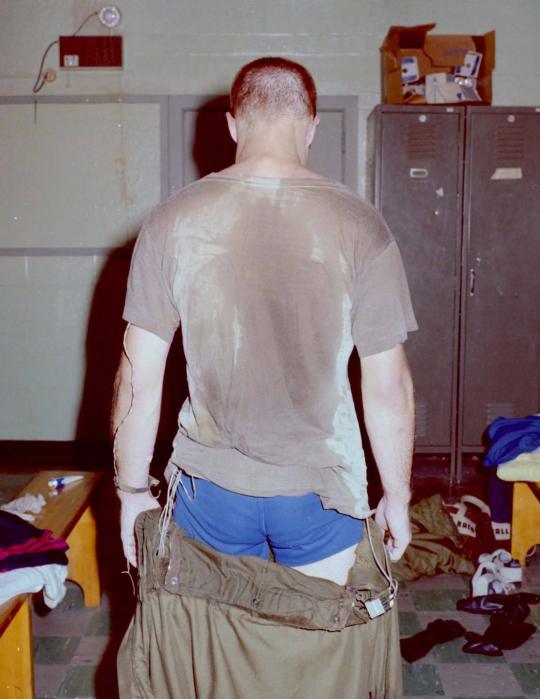
“Cooling Vest Test” | Military Research at Natick Soldier Systems Center. [1983]
734 notes
·
View notes
Text
Charles’ patches and pins :)

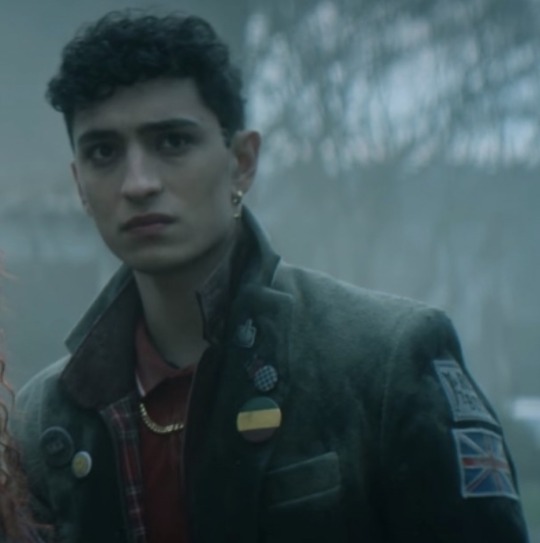


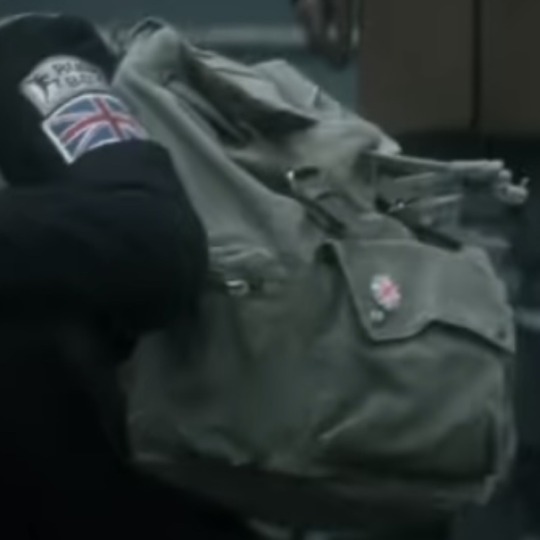
SKA pin: Quick History lesson because I had no idea what it was: definitely google more:
SKA is a music genre that originated in Jamaica. In the 70s a lot of Jamaicans immigrated to the UK. Punks and young Jamaican immigrants felt a sense of unity due to both being screwed over by the system. This led to 2 Tone SKA which mixed SKA with punk rock elements. While 2 Tone SKA is a genre, it was also a movement that focused on racial unity.
Rude Boy patch: In late 60s Jamaica RudeBoys were young “delinquents” who listened to rocksteady music. Term was used in England to refer to fans of SKA and 2 tone. Think the other insults used for punks that have been reclaimed.
Checker Print pin: Represents racial unity in the movement.
Target patch: Symbol for the Mod subculture. Google this one to.
Union Jack pin (on bag) and patch: He sure is British
Smiley face pin: I believe it’s just a generic smiley face but it could be a logo.
Unknown metal(?) pin: I can’t get a clear enough look at it to even begin to guess what it is.
Unknown pin: I have no idea. The one between the metal one and the checker print. No a clue.
Unknown flag(?) pin: A flag with horizontal blue, yellow, and red stripes but I can’t find anything with those colors in that order.
#correct me if I’m wrong on anything#I’ve been researching SKA for like an hour#I like they made Charles kinda punky#also while I was researching it said that ska got popular with white English kids and West Indian immigrant kids#and obvi came from Jamaica#and the actor who plays charles is half indian 1/4 Jamaican and 1/4 white#ALSO#Please let me know if you know what the hell that flag is#I have no clue#charles rowland#dead boy detectives#this all started because I wanted to know what that flag was#still don’t know#but I’ve watched a documentary on 2 tone SKA now#life update: my friend has made fun of me for not knowing what Ska is
106 notes
·
View notes
Text

Semiconductors: The Driving Force Behind Technological Advancements
The semiconductor industry is a crucial part of our modern society, powering everything from smartphones to supercomputers. The industry is a complex web of global interests, with multiple players vying for dominance.
Taiwan has long been the dominant player in the semiconductor industry, with Taiwan Semiconductor Manufacturing Company (TSMC) accounting for 54% of the market in 2020. TSMC's dominance is due in part to the company's expertise in semiconductor manufacturing, as well as its strategic location in Taiwan. Taiwan's proximity to China and its well-developed infrastructure make it an ideal location for semiconductor manufacturing.
However, Taiwan's dominance also brings challenges. The company faces strong competition from other semiconductor manufacturers, including those from China and South Korea. In addition, Taiwan's semiconductor industry is heavily dependent on imports, which can make it vulnerable to supply chain disruptions.
China is rapidly expanding its presence in the semiconductor industry, with the government investing heavily in research and development (R&D) and manufacturing. China's semiconductor industry is led by companies such as SMIC and Tsinghua Unigroup, which are rapidly expanding their capacity. However, China's industry still lags behind Taiwan's in terms of expertise and capacity.
South Korea is another major player in the semiconductor industry, with companies like Samsung and SK Hynix owning a significant market share. South Korea's semiconductor industry is known for its expertise in memory chips such as DRAM and NAND flash. However, the industry is heavily dependent on imports, which can make it vulnerable to supply chain disruptions.
The semiconductor industry is experiencing significant trends, including the growth of the Internet of Things (IoT), the rise of artificial intelligence (AI), and the increasing demand for 5G technology. These trends are driving semiconductor demand, which is expected to continue to grow in the coming years.
However, the industry also faces major challenges, including a shortage of skilled workers, the increasing complexity of semiconductor manufacturing and the need for more sustainable and environmentally friendly manufacturing processes.
To overcome the challenges facing the industry, it is essential to invest in research and development, increase the availability of skilled workers and develop more sustainable and environmentally friendly manufacturing processes. By working together, governments, companies and individuals can ensure that the semiconductor industry remains competitive and sustainable, and continues to drive innovation and economic growth in the years to come.
Chip War, the Race for Semiconductor Supremacy (2023) (TaiwanPlus Docs, October 2024)
youtube
Dr. Keyu Jin, a tenured professor of economics at the London School of Economics and Political Science, argues that many in the West misunderstand China’s economic and political models. She maintains that China became the most successful economic story of our time by shifting from primarily state-owned enterprises to an economy more focused on entrepreneurship and participation in the global economy.
Dr. Keyu Jin: Understanding a Global Superpower - Another Look at the Chinese Economy (Wheeler Institute for Economy, October 2024)
youtube
Dr. Keyu Jin: China's Economic Prospects and Global Impact (Global Institute For Tomorrow, July 2024)
youtube
The following conversation highlights the complexity and nuance of Xi Jinping's ideology and its relationship to traditional Chinese thought, and emphasizes the importance of understanding the internal dynamics of the Chinese Communist Party and the ongoing debates within the Chinese system.
Dr. Kevin Rudd: On Xi Jinping - How Xi's Marxist Nationalism Is Shaping China and the World (Asia Society, October 2024)
youtube
Tuesday, October 29, 2024
#semiconductor industry#globalization#technology#innovation#research#development#sustainability#economic growth#documentary#ai assisted writing#machine art#Youtube#presentation#discussion#china#taiwán#south korea
7 notes
·
View notes
Text
Watch me try to make sense on square boy sector‼️

There's some random things written on the drawing, it's mostly annotations and hcs
Its written :
"he does, like, mitosis" and them 3 littles balls on the side illustrating them multiplying
And under the doodles "The fairy is actually small and their wings grow slightly larger than them. If the fairy is transformed (in another form that's not the fairy one) the wings will be smaller by comparison."
Addition : Or not visible at all.
Also some sona doodles

I got pissed on class earlier and also wanted to draw the fit I was using today
I wrote "Pls get me out of this prison" there on the side
#after those doodles I started watching a documentary about bats#I think thats the point I ever wanted to reach on character obssesion field#THE RESEARCH OF MY LIFE (its not)#fop foop#fop irep#foop#fairly oddparents#fairly oddparents a new wish#fop a new wish#irep anticosma#my persona#doodles#fop headcanon#also need to say that I was surprised by the fact that I thought for my entire life that Foop was barefoot only do discover he wasn't#Paaelle arrrt
10 notes
·
View notes